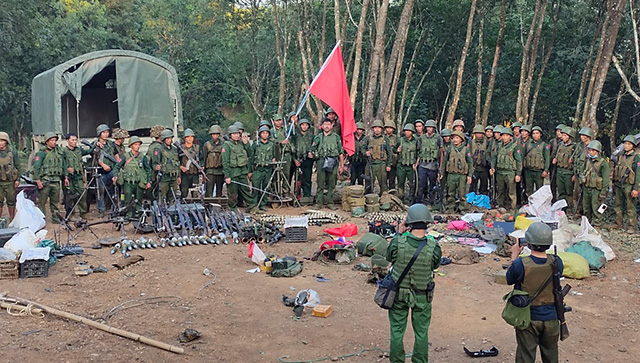In the tumultuous landscape of Southeast Asia, Myanmar finds itself entangled in a complex web of conflict. For the past three weeks, the military junta in Myanmar has been engaged in a fierce battle against rebel forces, with the epicentre in the eastern state of Shan. However, the ripples of this conflict have now reached the borders of India, creating a cause for concern and triggering a humanitarian crisis.
Seizure of Ri Khaw Dar The recent escalation occurred in the town of Ri Khaw Dar, situated across the border from Mizoram in India. The rebels, affiliated with the Chin National Army in the Chin State, attacked a Myanmar army base in the border town. Despite constant junta airstrikes, the rebels persevered and, by evening, successfully captured the town. This setback marks a continuation of the junta’s loss of ground and soldiers throughout the nation. The repercussions of the conflict are not limited to territorial losses for the junta. Mizoram, a state in India, has witnessed an influx of both refugees and surrendered Myanmar army troops. Over 5,000 people have sought refuge in villages along the border, and 42 Myanmar army soldiers have surrendered to Mizoram Police. This represents a significant challenge for India, as the tensions spill over and threaten to disrupt the region’s stability. Mizoram, Inspector General of Police, Lalbiakthanga Khiangte, said, “This morning again we still captured two Myanmar army (soldiers) and apart from that another one is also injured, that is already admitted in Champhai Civil Hospital yesterday evening itself. So the total Myanmar army (soldiers) who got surrendered and (caught) in hands of Mizoram police are 42 in number." Humanitarian crisis The crisis intensifies as tens of thousands of people become internally displaced within Myanmar, fleeing the ground fighting and retaliatory airstrikes by the junta. The magnitude of the refugee crisis is likely to grow, posing a considerable humanitarian challenge for both Myanmar and neighbouring countries. The rebellion that originated in the eastern Shan State on 27 October has now spread across Myanmar. The Brotherhood Alliance, formed by three rebel groups, claims to have captured key cities from Kalay in the north to Kunlong in the east, and even towns along the border with India and China. Videos released by the rebels depict their gains, including the capture of military outposts and the downing of a junta fighter jet in Kayah State. State of emergency In response to the escalating situation, the junta has imposed martial law in Shan, where the rebellion began. Curfews have been declared in the west, specifically in Rakhine State, as the junta attempts to regain control. The efficacy of these measures remains uncertain, raising questions about whether they will reverse the junta’s losses or further fuel the rebellion. This rebellion poses the most significant challenge to the military junta’s authority since the coup in February 2021. Previously dormant rebel groups have now mobilised, presenting a united front against the junta’s rule. The unfolding events underscore the junta’s struggle to contain the spreading fire of rebellion, and the coming days may bring even greater challenges to their authority. As Myanmar grapples with internal strife, the spillage of conflict across borders raises alarming concerns for neighbouring countries, particularly India. The humanitarian crisis, influx of refugees and the relentless rebellion present a formidable challenge to regional stability. The international community watches closely, awaiting the resolution of Myanmar’s internal turmoil and the potential consequences for the broader Southeast Asian region. Views expressed in the above piece are personal and solely that of the author. They do not necessarily reflect Firstpost’s views. Read all the Latest News , Trending News , Cricket News , Bollywood News , India News and Entertainment News here. Follow us on Facebook , Twitter and Instagram .
)